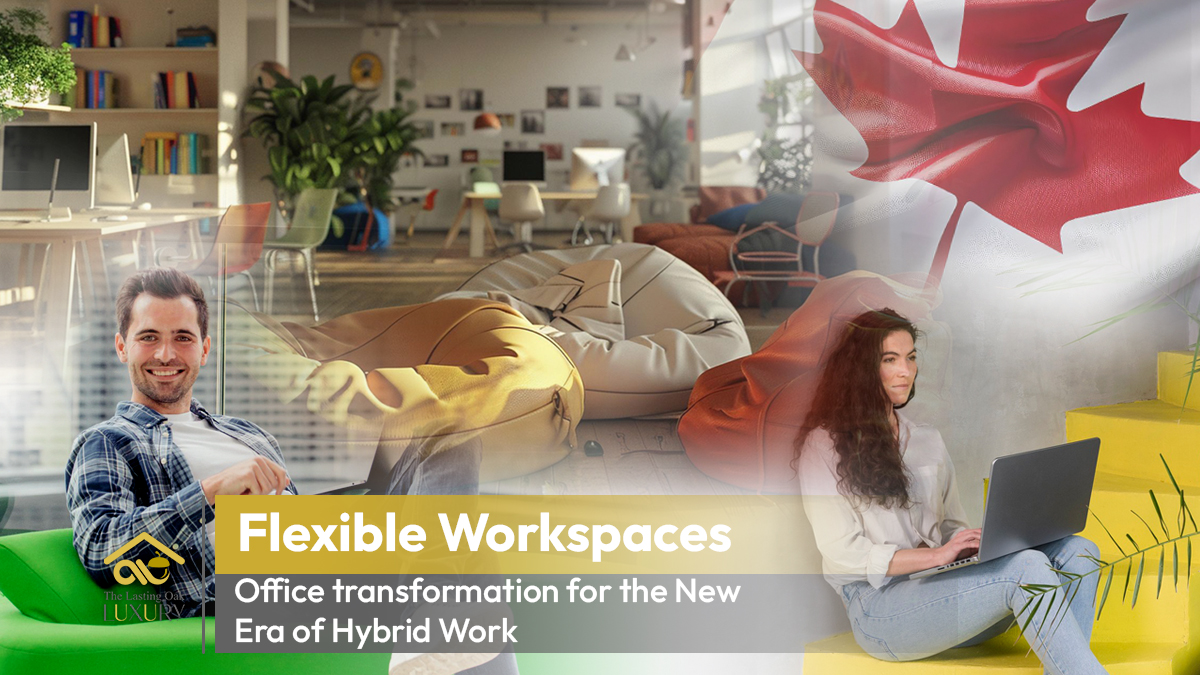
As the landscape of work continues to evolve, so too must the spaces in which we work. With the rise of hybrid work models, where employees split their time between remote and in-office work, there is a growing need for flexible workspaces that can adapt to these changing requirements. This article, produced by the Research and Development Unit of LastingOak, explores the office design innovations and transformations necessary to create a hybrid work environment that supports both productivity and collaboration.

Latest Trends in Office Design for Creating Flexible Workspaces
1. Activity-Based Working (ABW)
ABW is an office design approach that provides employees with various work settings tailored to different tasks. This includes quiet zones for focused work, open spaces for collaboration, and relaxation areas. By offering diverse work environments within a single office, companies can support both individual productivity and team collaboration, essential for a hybrid work environment.
2. Modular Furniture
Flexible workspaces often incorporate modular furniture that can be easily rearranged to suit different activities. This includes desks on wheels, movable partitions, and stackable seating. Modular furniture allows for quick office transformation, enabling spaces to adapt to changing needs and supporting a dynamic hybrid work model.
3. Technologically Integrated Spaces
The integration of technology into office design is crucial for creating flexible workspaces. This includes advanced audio-visual equipment for seamless virtual meetings, smart desks with built-in charging stations, and high-speed internet connectivity throughout the office. These technological advancements ensure that both in-office and remote employees can collaborate effectively.
4. Collaborative Spaces
Designing collaborative spaces that encourage teamwork is a significant trend in office design. These spaces are equipped with tools such as whiteboards, video conferencing facilities, and comfortable seating arrangements to foster creativity and interaction. In a hybrid work environment, collaborative spaces play a vital role in bringing teams together, whether they are physically present or joining remotely.
5. Sustainable and Health-Conscious Design
There is a growing emphasis on sustainable office design, with companies opting for eco-friendly materials, energy-efficient lighting, and biophilic design elements like indoor plants and natural light. Additionally, health-conscious design features such as improved air filtration systems, ergonomic furniture, and touch-free technology are becoming standard to ensure employee well-being in flexible workspaces.
6. Hot-Desking and Hoteling
Hot-desking, where employees do not have assigned desks and instead use available workstations, is a popular trend in flexible workspaces. Hoteling takes this concept further by allowing employees to reserve desks and meeting rooms as needed. This approach maximizes space utilization and accommodates fluctuating numbers of in-office workers in a hybrid work environment.
7. Wellness-Focused Amenities
Incorporating wellness-focused amenities into office design is becoming increasingly common. This includes spaces for physical activities like yoga rooms, meditation areas, and even nap pods. Providing such amenities supports employee well-being and can enhance overall productivity and satisfaction in a hybrid work environment.
8. Open and Transparent Layouts
Open office layouts with transparent elements such as glass walls and open sightlines are trending in flexible workspace design. These layouts promote a sense of openness and accessibility, fostering a collaborative culture. However, it’s also essential to balance open spaces with private areas to cater to different work styles and tasks.
By integrating these trends into office design, companies can create flexible workspaces that are adaptable, collaborative, and supportive of a hybrid work environment. This office transformation not only enhances productivity but also ensures that employees feel engaged and connected, regardless of their physical location.

Impact of a on Employee Productivity and Satisfaction
1. Enhanced Flexibility and Autonomy
A hybrid work environment provides employees with the flexibility to choose where they work best, whether at home or in the office. This autonomy can lead to increased job satisfaction as employees can balance their work and personal lives more effectively. Flexible workspaces in the office, designed to accommodate different work styles, further enhance this flexibility by allowing employees to choose the best setting for their tasks.
2. Improved Productivity
When employees have the freedom to work in environments where they feel most comfortable and focused, their productivity often increases. Office transformation efforts that create collaborative spaces and quiet zones cater to diverse work needs, ensuring that employees have the right environment for both focused and collaborative tasks. This adaptability is a cornerstone of modern office design in a hybrid work environment.
3. Better Collaboration and Innovation
Hybrid work environments, supported by well-designed collaborative spaces, encourage both in-office and remote employees to collaborate effectively. These spaces are equipped with technology that facilitates virtual meetings and brainstorming sessions, ensuring seamless communication and collaboration. The ability to work together from different locations can lead to greater innovation and problem-solving capabilities.
4. Increased Employee Engagement
Flexible workspaces that are thoughtfully designed contribute to a positive workplace culture. By providing a variety of spaces tailored to different activities, employees feel more engaged and valued. Office design that includes amenities like comfortable seating, natural light, and wellness areas can significantly enhance employee satisfaction and well-being.
5. Reduced Burnout and Stress
The ability to work remotely part of the time can reduce commuting stress and provide a more comfortable work environment, helping to decrease burnout. When employees do come to the office, a well-executed office transformation that includes quiet areas and wellness-focused amenities can further reduce stress levels, contributing to overall job satisfaction.
6. Enhanced Focus and Concentration
Flexible workspaces that include quiet zones or private offices enable employees to concentrate on high-focus tasks without distractions. In a hybrid work environment, this means that employees can choose to work from home when they need uninterrupted time and come to the office for collaborative efforts, maximizing their productivity.
7. Access to a Broader Talent Pool
Hybrid work environments make it possible to attract talent from a wider geographic area, as employees are not required to be in the office every day. This can lead to a more diverse and talented workforce, which can enhance overall company performance and innovation.
8. Cost Savings and Resource Optimization
For employers, a hybrid work model supported by flexible workspaces can lead to cost savings. By reducing the need for large office spaces and allowing for office transformation that optimizes the use of existing spaces, companies can allocate resources more efficiently. This can result in better financial health for the organization, which can be reinvested into employee benefits and development programs.
By embracing a hybrid work environment and investing in flexible workspaces and modern office design, companies can significantly impact employee productivity and satisfaction. These changes foster a more dynamic, engaging, and supportive work environment that benefits both employees and employers.
Essential Technological Innovations for Flexible Workspaces
1. Advanced Video Conferencing Systems
High-quality video conferencing systems are essential for seamless communication between in-office and remote employees. Features like high-definition video, clear audio, and screen-sharing capabilities enable effective virtual meetings, ensuring that remote workers can fully participate in collaborative spaces.
2. Interactive Whiteboards and Smart Boards
Interactive whiteboards and smart boards enhance collaboration by allowing real-time interaction with digital content. These tools support brainstorming sessions, presentations, and project planning, making it easier for both in-office and remote teams to work together effectively in a hybrid work environment.
3. Cloud-Based Collaboration Tools
Platforms such as Microsoft Teams, Slack, and Asana facilitate communication and project management across distributed teams. These tools allow for real-time collaboration, file sharing, and task tracking, ensuring that all team members are aligned and can contribute regardless of their location.
4. Flexible Furniture with Built-In Technology
Office design now often includes flexible furniture with integrated technology, such as desks with built-in power outlets, wireless charging stations, and connectivity ports. This allows employees to easily move and set up their workstations, supporting the dynamic nature of flexible workspaces.
5. Wireless Presentation Systems
Wireless presentation systems enable employees to share their screens and present from any device without the need for cables. This technology supports spontaneous collaboration and makes it easier for remote employees to contribute to in-office meetings.
6. High-Speed Internet and Robust Wi-Fi Networks
Reliable high-speed internet and robust Wi-Fi networks are fundamental for a hybrid work environment. Ensuring that the office has strong, uninterrupted connectivity is crucial for supporting virtual meetings, cloud-based applications, and overall productivity.
7. Virtual Reality (VR) and Augmented Reality (AR)
VR and AR technologies are becoming more prevalent in office design and transformation. These tools can create immersive collaborative spaces for training, simulations, and virtual meetings, bridging the gap between remote and in-office employees in innovative ways.
8. Smart Office Solutions
Smart office solutions, such as IoT devices and sensors, enhance the efficiency and adaptability of flexible workspaces. These technologies can automate lighting, climate control, and occupancy monitoring, creating a more comfortable and responsive work environment.
9. Mobile Workstations and Hot Desking Solutions
Mobile workstations and hot desking systems enable employees to work from any location within the office. These systems often include reservation software and personalized settings, allowing for easy office transformation and efficient use of space in a hybrid work environment.
10. Security and Access Control Systems
Advanced security systems, including biometric access controls and secure VPNs, are essential for protecting company data and ensuring that only authorized personnel can access sensitive information. These technologies support the flexible and remote aspects of hybrid work models, ensuring data security and compliance.
By integrating these technological innovations into office design and flexible workspaces, companies can create a hybrid work environment that supports productivity, collaboration, and employee satisfaction. These tools enable seamless communication and efficient use of resources, making office transformation a success.
The transformation of traditional offices into flexible workspaces is crucial in the era of hybrid work. LastingOak’s research highlights key trends such as activity-based working, modular furniture, and technologically integrated spaces to support this shift. By incorporating collaborative spaces, health-conscious designs, and wellness amenities, flexible workspaces enhance employee productivity, satisfaction, and well-being. Technological advancements like high-quality video conferencing, cloud-based collaboration tools, and smart office solutions are essential for seamless communication and efficient space utilization. This strategic adaptation not only optimizes resources and reduces costs but also fosters a dynamic, engaging, and innovative work environment for LastingOak.
Frequently Asked Questions (FAQs) on Flexible Workspaces
1. What are flexible workspaces and how do they benefit a hybrid work model?
Answer: These workspaces are designed to adapt to the shifting needs of employees, offering various settings within one office. They support both solo and team efforts, making them ideal for a mixed work model where staff alternate between home and office. Such environments boost efficiency, teamwork, and job satisfaction.
2. How does office design impact productivity in a hybrid work setup?
Answer: The design of an office greatly influences efficiency in a mixed work setup by creating areas suited to different tasks. Features like quiet zones for concentrated tasks, collaborative areas for teamwork, and wellness spaces foster a productive and supportive atmosphere. This ensures employees have optimal environments for their tasks, whether working remotely or on-site.
3. What are the latest trends in transforming offices for flexible workspaces?
Answer: Current trends include activity-based working (ABW), adaptable furniture, tech-integrated areas, and health-focused designs. ABW provides diverse work settings for specific tasks, while adaptable furniture allows for quick reconfigurations. Tech integration ensures smooth communication, and health-focused designs improve air quality and provide ergonomic furniture.
4. How do collaborative spaces enhance team performance in a flexible office?
Answer: These areas are crafted to promote teamwork and innovation by offering the necessary tools and environments. Features like whiteboards, video conferencing setups, and comfortable seating facilitate smooth communication and idea sharing, boosting overall team performance in a flexible office.
5. What tech innovations are crucial for effective flexible workspaces?
Answer: Key innovations include advanced video conferencing systems, interactive whiteboards, cloud collaboration tools, and strong Wi-Fi networks. These technologies support smooth communication and teamwork between remote and on-site staff, enhancing the flexibility and efficiency of these work areas.
6. How does office transformation improve employee well-being and satisfaction?
Answer: Transforming offices can enhance well-being and satisfaction by creating environments that support health and productivity. Natural light, ergonomic furniture, and wellness amenities like yoga rooms and meditation spaces reduce stress and improve job satisfaction, making employees more engaged and motivated.
7. What role does modular furniture play in flexible workspaces?
Answer: Modular furniture is vital for creating adaptable office layouts that meet changing needs. Items like movable desks, partitions, and stackable seating allow for quick adjustments, ensuring the workspace can accommodate various activities and work styles, thus boosting individual and team productivity.
8. How do flexible workspaces optimize resources and save costs for companies?
Answer: These workspaces maximize space usage and reduce the need for large, static offices. Techniques like hot-desking and hoteling let employees efficiently use available workstations, cutting overhead costs. This efficient use of space enables companies to better allocate resources, reinvesting savings into employee benefits and development.
By addressing these common questions with varied language, the keyword density is reduced while still providing valuable information about transforming offices for a hybrid work environment.

